AMD Radeon HD 7870 GHz Edition & Radeon HD 7850 Review: Rounding Out Southern Islands
by Ryan Smith on March 5, 2012 12:01 AM ESTPower, Temperature, & Noise
As always, we wrap up our look at a new video card with a look at the physical performance attributes: power consumption, temperatures, and noise. Thanks to TSMC’s 28nm process AMD has been able to offer 6900 series performance on a much smaller chip, but what has that done to power consumption and all of its related properties? Let’s find out.
Please note that we’re including our 7870-based 7850 in these charts, even though none of AMD’s partners will be shipping a card in this exact configuration. Power consumption should be nearly identical to shipping cards, but temperatures and noise readings are going to be significantly different since most of those cards will be using open air coolers.
| Radeon HD 7800 Series Voltages | ||||
| Ref 7870 Load | Ref 7850 Load | Ref 7870 Idle | ||
| 1.219v | 1.213v | 0.85v | ||
When getting a voltage reading on our 7800 cards through GPU-Z, it was interesting to note that the load voltage was almost identical between the two cards: 1.219v versus 1.213v. While we believe GPU-Z is giving us the right readings, we’re not sure whether the 7850 voltages are the same we’ll be seeing on shipping cards because of the PCB differences.

Idle power consumption looks quite good, as you’d expect from GCN. Idle power consumption is virtually identical to the 7900 series at the wall, and only the 7700 series can beat 112W. This further goes to show just how much progress has been made with idle power consumption – the Cayman based 6900 series had good idle power consumption for its time, and yet the 7800 series beats it by 5W+ at the wall.
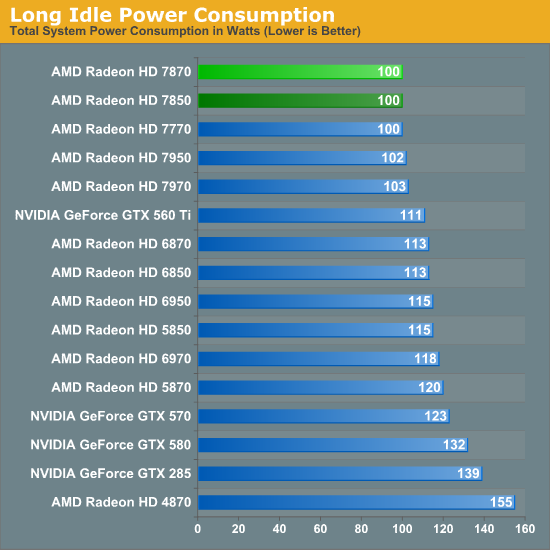
Long idle power consumption is virtually identical with the rest of the Southern Islands cards thanks to AMD’s ZeroCore Power technology. The next closest card is the GTX 560 Ti, and that’s at nearly 10W higher.
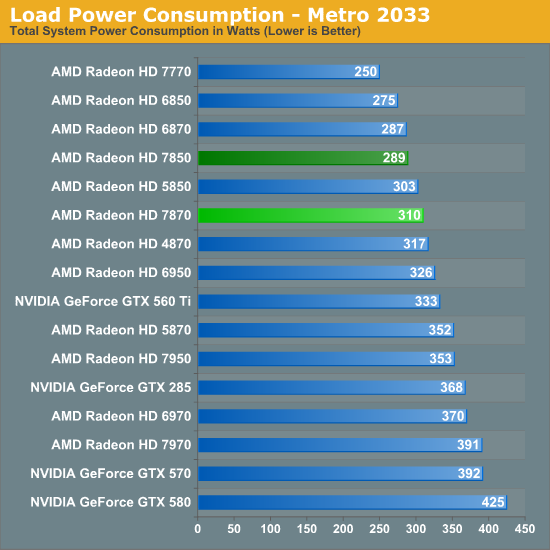
Moving on to load power testing, we have Metro 2033. Load power consumption here is about where you’d expect it to be, with the 7800 setups drawing more at the wall than the 6800 setups, but less than the 7900 and 6900 series. This is largely a consequence of performance, as the higher rendering performance of the 7800 series versus the 6800 series drives up CPU power consumption in order to generate more frames.
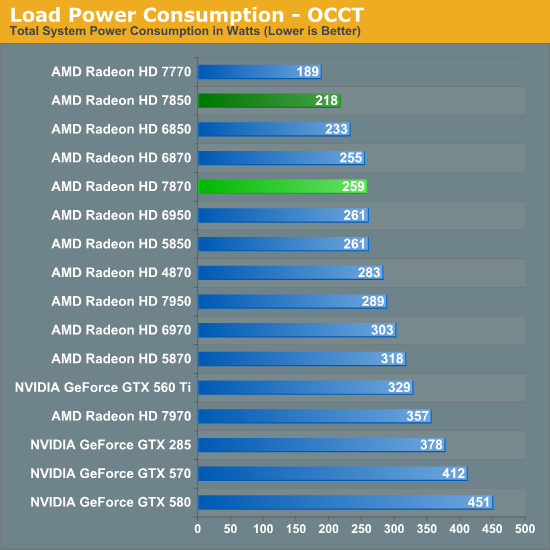
OCCT on the other hand gives us a more purified look at power consumption, and as you’d expect for 28nm it looks good. The 7870 ends up drawing only a few more watts at the wall compared to the 6870, showcasing the fact that the 7800 series is a drop-in replacement for the 6800 series from a power consumption perspective. The 7850 looks even better, capping out at 15W below the 6850, most likely as a result of PowerTune keeping the card firmly at 150W. Though it’s interesting to note that the measurements at the wall don’t perfectly align with the differences in PowerTune limits, with the 7850 drawing 30W more than the 7770 at the wall compared to a 50W PT difference, while the 7950 draws 30W more at the wall over the 7870 even though there’s only supposed to be a 10W PT difference.
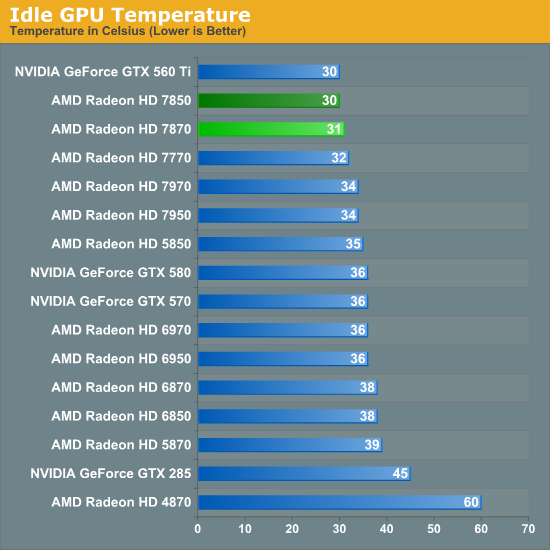
AMD’s latest generation blowers do quite well with idle temperatures and we can see it here. At 30C for the 7850 it’s every bit as cool as the GTX 560 Ti, while the entire 7800 series is around 5-8C cooler than the 6900.
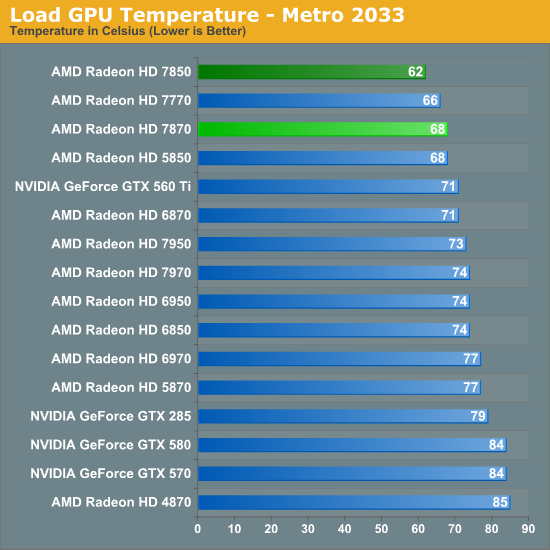
Under load, Metro temperatures are also quite good. At 62C the 7850 is the coolest card in this performance class, but keep in mind that it’s basically using an oversized cooler; retail cards will be open air coolers with much different characteristics. Otherwise at 68C the 7870 is still among the coolest cards, coming ahead of even the historically cool GTX 560 Ti, never mind the much hotter 6900 series.

Load temperatures climb under OCCT, but again the 7800 series is among the coolest temperatures we see. Here we see the 7870 peak at 73C, whereas its last generation counterpart would be at 80C and the GTX 570 at a toasty 87C.
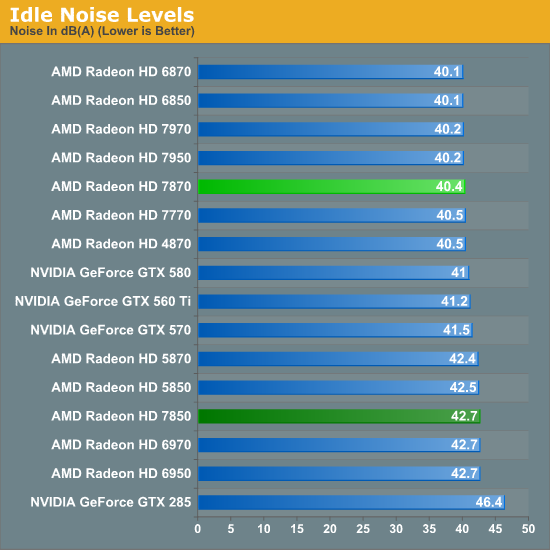
Moving on to noise testing, there are no major surprises at idle, with the 7870 hugging 40db. For whatever reason the 7850’s minimum fan state is roughly 200RPM higher than the 7870’s, but since no one will be using this cooler it’s not a significant result.
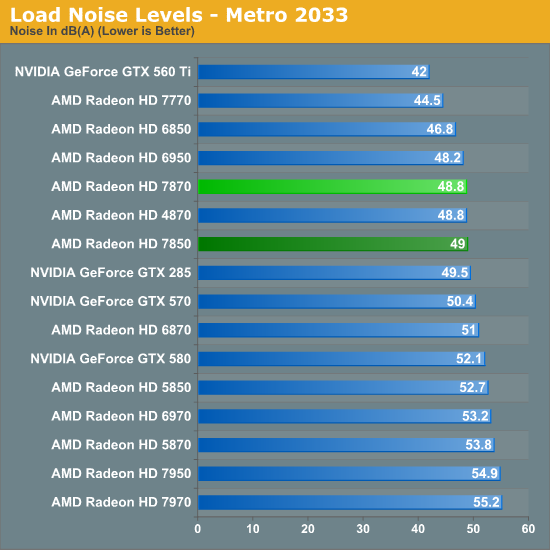
Consistent with AMD’s other 7000 series cards, we’re once again seeing the consequences of AMD’s aggressive cooling policies coupled with the use of a blower. At 48.8dB the 7870 is still quieter than the blower-based 6870, but it’s significantly louder than the open air cooled GTX 560 Ti, even though the latter consumes far more power and generates far more heat. This doesn’t make the use of a blower the wrong choice, but combined with aggressive cooling policies it does hurt AMD. The GTX 570, in spite of using much more power than the 7870, is only less than 2dB louder even though it too uses a blower.

Last, but not least we have our OCCT noise results. Unlike Metro the 7800 series does better on a relative basis here, but this is mostly because NVIDIA doesn’t have a power throttling system quite like PowerTune. At 51.9dB the 7870 is not the quietest card, but it still manages to beat the 6970 and the PowerTune-less 6870.
All things considered there are no great surprises here on a relative basis, as the 7800 series performs like we’d expect for a blower based sub-200W video card. Due to TSMC's 28nm process AMD greatly improves on their performance/power and performance/noise ratios with the 7800 series compared to the 6800 and 6900 series, while for their power class the 7800 series is slightly ahead of the pack on both power consumption and noise.
With that said, keep in mind that since most of AMD’s partners will be using open air coolers these results won’t be applicable to most retail cards. So for the temp/noise characteristics of retail cards you’ll want to look at individual card reviews when those start appearing later this month. This is particularly true for the 7950, where all of the retail cards will be using a different design than our sample.










173 Comments
View All Comments
fingerbob69 - Tuesday, March 6, 2012 - link
It ain't, the 7870 is faster by 25-33% depending on the res. Price wise it's about 30% more (UK) but that fits with the bump in performance. So, you're wrong.Houdani - Monday, March 5, 2012 - link
Hey! My mom was born on Pitcairn. It's the top of a blown off volcano, only 1x2 miles large. No correlation, I'm sure. Interesting.AlB80 - Monday, March 5, 2012 - link
It beats 6950. 6970 and 7850. Is it correct?haukionkannel - Monday, March 5, 2012 - link
Well these are good card even at this moment! Ofcource we can hope cheaper prizes, but that need at least two competitors and at this moment there is none...And I would not wonder if Kepler will be prices accordingly. Those kepler chip are bigger, if leak are true, so they should be faster and they definitely will be more expensive (if not counting those renamed low end cards tha allso AMD is releasing this time)
AMD is not getting profit (in total) and Nvidia has a lot of new staff going on that need a lot of money to develop, so there seems to be zero reason to both company to reduce the prices... pity but true.
If you have good 5000 or 6000 series card you don't need these (same as if you have good 6600 serieas cpu you don't need ivy...) at this moment. But if you need a lot of power for little power usage these are extremely good and allso as someone said, these are very small chips! So there is a lot of room for a little bit bigger for 8000 series. Tick tock... Seems to be a lot like Intel Ivy vs Hasvell. Ivy does not offer a much compared to sandy, only smaller power usage and a little bit better speed. Like someone else said, very similar situation.
Hubb1e - Monday, March 5, 2012 - link
The upgrade from a 5800 to a 7800 may be only 20-40% on stock clocks, but add in the extra headroom the 7800 has when overclocking and you're looking at a decent upgrade. Once the prices come down on these I'm sure you'll see quite a few folks dropping their 5800 for a 7800.PurpleMoose - Monday, March 5, 2012 - link
The 7850 (usually) slightly outperforms the 6950 despite having only 1024 shaders compared to 1408, with a ~7% core overclock (and a slight memory underclock). Even being conservative, that would make the GCN shaders about a third more efficient than the VLIW4 ones. But if we assume that a VLIW4 cluster performs more or less the same as a VLIW5 cluster, as does seem to be the case, then we can compare a hypothetical VLIW4-based 5770 with 640 shaders to the 7770. In this case the 7770 outperforms the 5770 basically by its clock speed difference, in other words clock for clock, shader for shader, VLIW4/5 vs GCN seems to be a wash.So why doesn't the 7700 series show as much (ie any) improvement?
The most obvious deficiency is the memory bus and memory bandwidth, but if thats the case why not add more? Alternatively, if you're happy with the performance as is, why not cut away a few more shader groups as it seems the card really can't use them, and save even more space? I had a very brief look for overclocked results and couldn't really find any - what I'd find really interesting is if anyone has benched a stock 7770 against a 7750 running at 7770 frequencies. I wonder how much the loss of shaders would hurt.
jesh462 - Monday, March 5, 2012 - link
Whenever I read an article on the new 7xxx series, I can't help but wonder if people remember what they're looking at. AMD moved to 28nm with this series. They also introduced a completely new architecture. They did so with no complications and without going overtime on the release date.This hasn't been done before. Even Intel doesn't attempt to do this with their CPUs. Tick, then tock, right?
Not only did AMD manage to get their new line up out, but the new cards have performance that exceeds their Nvidia counterparts on both the gaming and compute levels, in most cases. People who buy actual retail samples of the 7xxx series are pleased with the great overclocking headroom. It's obvious that there is a lot of room, even in the 7xxx series current iteration, for growth.
Despite all this, I still see people talk about how a 7xxx card isn't worth it, and how AMD is a sh*t company. Really? Ok.
Disclaimer, I own an i7 laptop with a geforce 560 blah blah.. fanboy whatever. Just think about this before you post. Yeah the new cards could use a price drop. We all know they will, sooner or later. That's why it's called the waiting game.
arjuna1 - Monday, March 5, 2012 - link
a 7xxx card is not worth it and AMD is not a sh*t company.I tend to agree with you for the most part but, there are no NVIDIA's counterparts for the 7xxx series, yet, and when there is, the 7xxx will go down in prices and then their value will increase.
CeriseCogburn - Thursday, March 8, 2012 - link
I'm sorry, we were promised southern islands for the 6000 series, and then, all that changed...What we really have here is a release that is like 2 years late.
Apparently once AMD re-announces it's new release schedule after admitting it missed it's last release target... all you people suddenly get a gigantic case of perfect amnesia.
To put it simply this is AN ENTIRE GENERATION LATE ON THE PROMISED RELEASE.
mattgmann - Monday, March 5, 2012 - link
Where is this misconception that the pricing is anywhere near acceptable on these new parts coming from? So they fit right in with the current price/performance ration. So what? AMD has basically put out a new line of cards that match their competitors previous generation and cost SLIGHTLY less.Aren't technologies supposed to get better? What's the point in upgrading if you get basically the same amount of performance for your dollar today as when you bought you last part?
Intel's new top end processors cost the same as last generation's, and the generation before that. New products replace old ones in pricing structures. AMD is raking in cash on these cards. They're less expensive to produce than last generation and retail for MORE money.
AMD is taking full advantage of their current market position, and instead of passing on ANYTHING to the consumer, is milking every profitable drop.
These cards' performance is impressive when compared apples to apples against last generation's equivalents. But since they basically all occupy a price slot a full tier higher than their predecessors, the comparison is moot.
Too bad the only 2 companies in the graphics card race are so ill equipped to advance the industry. AMD, Nvidia, get a clue.